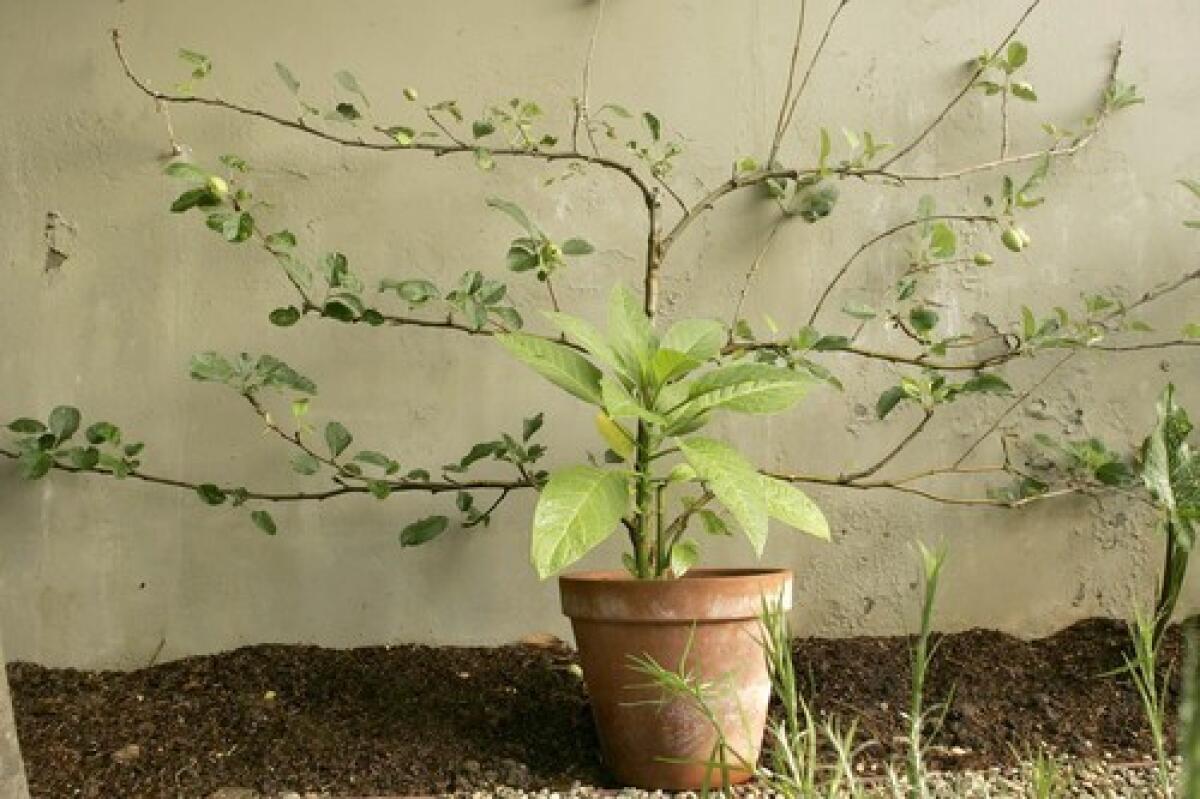Espalier, a top-tier technique

POOR espalier. Somehow this no-nonsense, salt-of-the-earth gardening technique acquired a hopelessly frilly name. Espalier summons to mind the kind of highbrow, highfalutin style of gardening demanded by snooty royals. It sounds like the directive of a lisping dauphin, of an obsessive garden despot. How unfortunate, for in truth, espalier is one of our most overlooked and useful gardening techniques.
Steve Gerischer, a Los Angeles landscape designer and human encyclopedia of all things horticultural, loves espalier techniques because “the trees can get by with so little once they’re established.”
It’s that “establishing” thing that frightens many gardeners away. Reading books on the proper tending of espaliered trees is a bit like reading the tax code. They can leave gardeners more confused than before. In practice, espalier is far simpler than many books would lead you to believe.
For the record, espalier is pronounced es-PAL-yur, or for the French-inclined, es-PAL-yay, or for the cowboy-inclined, yippee-KIE-yay. The word comes from the French-derived “epaulet,” which you’ll remember from your Swiss boarding school days means “shoulder strap.”
Certain shrubs (such as pyracantha) and trees with pliant, flexible limbs (such as apple) are trained to grow flat against a wall, fence or lattice. The branches are often forced to grow away from the main trunk at right angles -- a practice that gives the tree the appearance of having shoulders. Hence, epaulet.
Europeans in medieval times are generally credited with inventing the method. Having walled in their gardens to prevent unicorns and young dragons from eating their crops, these humble people discovered that growing fruit trees the old-fashioned way just wouldn’t do. They didn’t have enough space. So, in the name of progress, they began to grow their plums and figs in 2-D, secured to the very walls that had created the dilemma.
To their delight and amazement, they found their fruits grew healthier. A stone wall holds heat, allowing an apple to continue fruiting into the colder months. The geometric pruning of the limbs provides light and air flow to the entire plant, which lets energy and nutrients distribute equally. A single espaliered apple tree could produce 50 flawless apples this way. Serfs stopped falling out of trees. Gregorian chants went up-tempo. It was the gardening equivalent of putting wheels on suitcases.
The benefits of espalier plants -- and the space constraints that led to their development -- remain today. As more Californians build homes up and out, they often find that they’re pinched for dirt. They don’t own enough acreage to create those gardens envisioned in dreams or in glossy magazines. They’re ground deprived. That’s where espalier enters the plot.
More nurseries are stocking trees that have already been “tiered” -- plants that have already been trained into the classic cross-T shapes. Gerischer recommends buying a pre-trained plant to jump-start your experience. Having to wait years for a tree to begin bearing fruit seems un-American to many gardeners. “But if you buy a 3-year-old tree with its architecture firmly in place,” says Gerischer, of Larkspur Design, “you’ll only have two years of patience to deal with.”
One of the rewards of training plants in this manner is the gentle education the plants give back to you. Just working with the trees, making occasional snips here and there, will inform you remarkably well. Soon you’ll recognize a fruit spur. You’ll see how pinching back leaders affects growth. You learn that limes, pomegranates and other plants prefer to be trained in fan shapes, their trunks cut low to the ground with branches spreading out like a deck of cards.
Often you’ll need only your fingers to do the work -- rubbing off errant buds, retying branches to the frame, picking the fruit and buffing it on your T-shirt before taking a bite. What at first sounded like a ton of work and fussing is, actually, pretty darn easy.
“Almost any fruit tree can be espaliered,” says Tom Spellman, an arborist in La Verne working for wholesale supplier Dave Wilson Nursery. “For the most part, you can grow them into any shape you’d like.”
One terrific espalier that Spellman’s wholesale nursery has provided to local retail outlets is an apple tree that has been grafted to produce a different type of apple on each row. The first row sets out Fuji apples, the second Anna, and the third Golden Dorsett. This creates an extra long apple season as the varieties take turns fruiting.
But you don’t have to stick with apples.
“Meyer lemons are real forgiving if you make a mistake,” Spellman says. “Say you accidentally break off a new branch that you wanted to train. With a lemon’s quick summer growth, you’ll almost always get a new shoot coming right back.”
Figs can be trained on a wall with southern exposure -- walls that are often too hot from the sun to permit plant growth on them. Figs are trained in a more rambling style than apples and look like giant puzzle pieces, Gerischer says, “or like something Matisse would paint on the side of your house.”
Nectarines, peaches, apricots, pears, even avocados will work. Purely ornamental plants too. Japanese maples, Camellia sasanqua, Euonymus alata, forsythia, fuchsia, viburnum and Magnolia grandiflora all can be coaxed into fantastic displays. Once established, an espaliered tree or shrub can live for quite some time, a few hardy specimens can last as long as 125 years.
At this point in summer, espalier plants at nurseries are fully leafed out, some with fruit, some in flower. It’s easy to imagine what they will look like in a yard. Come January, when the plants are sold bare-root, they will look wimpy and unpromising -- like something only Charlie Brown could love. See them now, in their prime, and you might whip up the courage to try them.
Tony Kienitz is the author of “The Year I Ate My Yard.”
INFOBOX
Where to find espaliers
Dave Wilson Nursery, based near Modesto, is a major supplier of espaliered trees in Southern California. Its website lists more than 30 local nurseries that carry the trees. The company also offers a pamphlet on espalier and on fruit-tree care. Go to www.davewilson.com.
Other good resources
“How to Grow Vegetables & Fruits by the Organic Method”: Edited by J.I. Rodale (Rodale, 2000).
“The Complete Book of Edible Landscaping”: Rosalind Creasy (Sierra Club, 1982).
“California Master Gardener Handbook”: Edited by Dennis R. Pittenger (University of California, 2002).






